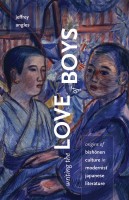 Author: Jeffrey Angles
Author: Jeffrey Angles
Publisher: University of Minnesota Press
ISBN: 9780816669707
Released: February 2011
I’ve recently become rather enamoured with Edogawa Rampo and his writings which is how I happened to come across Jeffrey Angles’ Writing the Love of Boys: Origins of Bishōnen Culture in Modernist Japanese Literature. Published by the University of Minnesota Press in 2011, the volume is an extension of Angles’ 2004 PhD dissertation “Writing the Love of Boys: Representations of Male-Male Desire in the Literature of Murayama Kaita and Edogawa Rampo.” Angles is currently an associate professor of Japanese literature, language, and translation at Western Michigan University. His primary research interests include translation, modern Japanese poetry, and romance and sexuality in Japanese literature, and especially the portrayal of same-sex desire. All of these subjects are at least touched upon if not thoroughly explored in Writing the Love of Boys. They are all topics that I am particularly interested in as well, so I was rather pleased to discover Writing the Love of Boys while searching for more information on Rampo and his works.
In Writing the Love of Boys, Angles examines the expression of same-sex desire, and specifically male-male desire, in Japanese literature during the late Taishō era (1912-1926) and early Shōwa period (1926-1989). In doing so he focuses on the work of three authors in particular: Murayama Kaita (1896-1919), who was also a poet and a painter; Edogawa Rampo (1894-1965), an incredibly influential writer of detective and mystery fiction among other things; and Inagaki Taruho (1900-1977), whose avant-garde work is noted as being particularly innovative. All three of these authors produced work that either incorporated or directly addressed male-male desire of both homosocial and homoerotic nature. Writing during a time in which attitudes towards sexuality in Japan were changing due to the influence of new medical and psychological approaches, Kaita, Rampo, and Taruho portrayed male-male desire in a way that was different from their immediate predecessors. Placing them within this historical and literary context, Angles also shows how their work would influence creators who followed them as well.
Another subject that is particularly important in Writing the Love of Boys is the erotic grotesque nonsense movement and fad of the 1920s and 1930s. Ero guro literature allowed its authors to explore the bizarre and the strange, including sexual desire that was considered by society to be perverse. However, although Kaita, Rampo, and Taruho were all involved in the rise of ero guro literature, Angles argues that their portrayal of male-male desire was frequently sympathetic and even subversive within the context of the genre which generally used sexuality for the purpose of titillation. Of the three authors that Angles focuses on in Writing the Love of Boys, it is Rampo who is the most well-known in English and who has had more of his work translated. Reading Angles’ analyses and translated excerpts of these three authors’ work, I can’t help but lament the fact that more of their writing isn’t currently available in English. But even though most of the works discussed in Writing the Love of Boys have yet to be released in translation, it is still interesting and valuable to learn about their place and importance within the literary and queer history of Japan.
For me, one of the most intriguing parts of Writing the Love of Boys was the literary lineage that Angles outlines, beginning with Kaita, who influenced Rampo, who in turn collaborated with Taruho, who was a direct inspiration to Takemiya Keiko, one of the creators whose work in the 1970s would lay the foundation for the entire boys’ love genre. In fact, much of the conclusion of Writing the Love of Boys is devoted to the lasting influence and legacies of Kaita, Rampo, and Taruho that can be seen in boys’ love manga. Angles credits Taruho as one of the authors who began developing an aesthetic of male-male desire for a female audience; several of his stories, including his debut, were published in magazines for women. This is one of the links that Angles uses to tie these three authors to the more recently developed genre of stories featuring male-male love primarily written for women by women. To some extent it does feel a little tangential to the work as a whole, and it was somewhat jarring to jump from the 1930s to the 1970s and beyond, but there is a legitimate connection. I found Writing the Love of Boys to be incredibly fascinating; it ended up addressing more of my interests than I initially realized it would—queer theory, ero guro, and even manga, in addition to many other topics.
